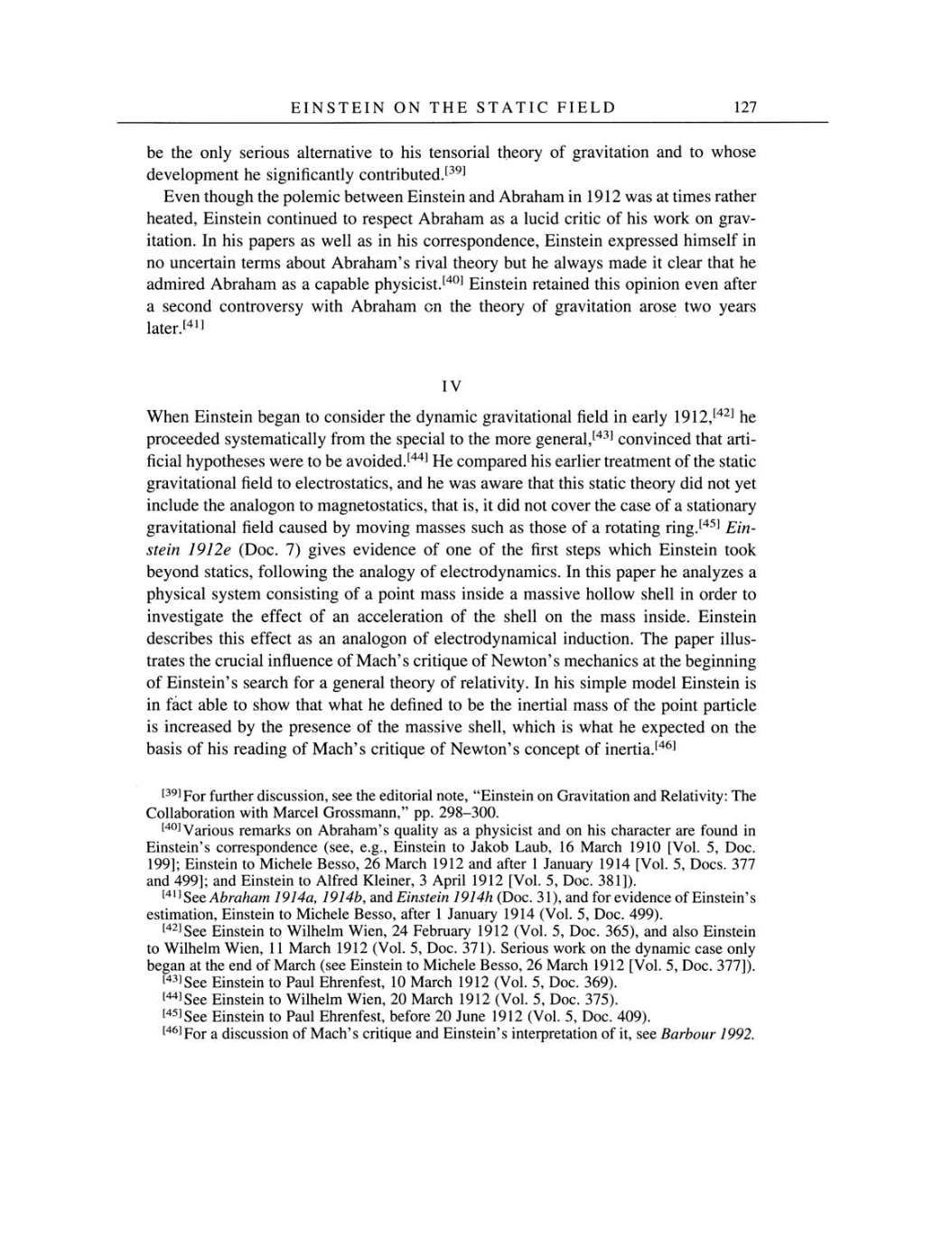EINSTEIN
ON THE
STATIC
FIELD
127
be the
only
serious alternative
to his
tensorial
theory
of
gravitation
and
to
whose
development
he
significantly
contributed.[39]
Even
though
the
polemic
between Einstein
and
Abraham
in 1912
was
at
times rather
heated,
Einstein continued
to
respect
Abraham
as a
lucid critic of
his
work
on
grav-
itation.
In
his
papers
as
well
as
in his
correspondence,
Einstein
expressed
himself
in
no
uncertain
terms
about Abraham's rival
theory
but
he
always
made
it
clear that he
admired Abraham
as a
capable
physicist.[40]
Einstein retained
this
opinion
even
after
a
second
controversy
with Abraham
on
the
theory
of
gravitation
arose
two
years
later.[41]
IV
When Einstein
began
to consider
the
dynamic gravitational field
in
early
1912,[42]
he
proceeded systematically
from the
special
to
the
more general,[43]
convinced that
arti-
ficial
hypotheses were
to
be
avoided.[44] He
compared
his
earlier
treatment
of
the
static
gravitational
field to
electrostatics,
and he
was aware
that
this
static
theory
did
not
yet
include the
analogon
to
magnetostatics,
that
is,
it
did
not
cover
the
case
of
a stationary
gravitational
field
caused
by moving
masses
such
as
those of
a
rotating
ring.[45]
Ein-
stein 1912e
(Doc. 7)
gives
evidence of
one
of the
first
steps
which Einstein took
beyond
statics,
following
the
analogy
of
electrodynamics.
In this
paper
he
analyzes
a
physical system consisting
of
a
point
mass
inside
a
massive hollow
shell in
order
to
investigate
the effect of
an
acceleration of the
shell
on
the
mass
inside. Einstein
describes
this
effect
as an
analogon
of
electrodynamical
induction. The
paper
illus-
trates
the crucial influence of Mach's
critique
of Newton's mechanics
at
the
beginning
of Einstein's search for
a
general theory
of
relativity.
In his
simple
model Einstein
is
in
fact able
to
show that what
he
defined
to be
the inertial
mass
of the
point particle
is
increased
by
the
presence
of the massive
shell,
which
is
what
he
expected
on
the
basis of his
reading
of Mach's
critique
of Newton's
concept
of
inertia.[46]
[39]For
further
discussion,
see
the editorial
note,
"Einstein
on
Gravitation and
Relativity:
The
Collaboration with Marcel
Grossmann,"
pp.
298-300.
[40]Various remarks
on
Abraham's
quality
as a
physicist
and
on
his character
are
found
in
Einstein's
correspondence
(see,
e.g.,
Einstein
to
Jakob
Laub,
16
March
1910
[Vol. 5,
Doc.
199];
Einstein
to
Michele
Besso, 26
March
1912
and after
1
January
1914
[Vol. 5,
Docs. 377
and
499];
and Einstein
to
Alfred
Kleiner,
3
April
1912
[Vol. 5,
Doc. 381]).
[41]See
Abraham
1914a, 1914b,
and Einstein 1914h
(Doc. 31),
and
for evidence of Einstein's
estimation,
Einstein
to
Michele
Besso,
after
1
January
1914
(Vol.
5,
Doc.
499).
[42]See
Einstein
to
Wilhelm
Wien, 24
February
1912
(Vol.
5,
Doc.
365),
and
also
Einstein
to
Wilhelm Wien,
11
March
1912
(Vol.
5,
Doc.
371).
Serious work
on
the
dynamic
case only
began
at
the end of March
(see
Einstein
to
Michele
Besso, 26
March
1912
[Vol. 5,
Doc.
377]).
[43]See
Einstein
to
Paul
Ehrenfest,
10
March
1912
(Vol.
5,
Doc.
369).
[44]See
Einstein
to
Wilhelm
Wien, 20
March
1912
(Vol.
5,
Doc.
375).
[45]See
Einstein to
Paul
Ehrenfest,
before
20
June
1912
(Vol.
5,
Doc.
409).
[46]For
a
discussion of Mach's
critique
and Einstein's
interpretation
of
it, see
Barbour
1992.
